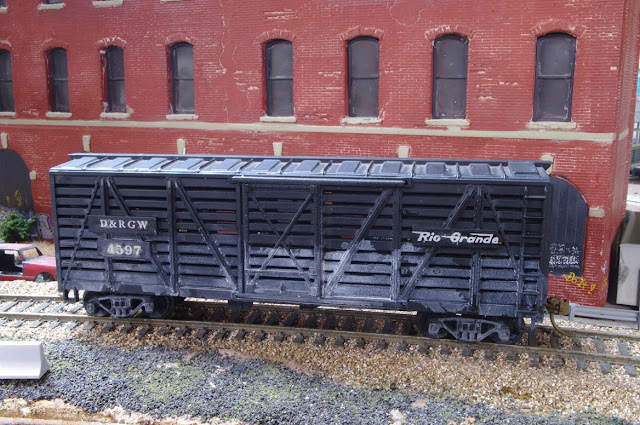I recently got one of the new ScaleTrains Norfolk Southern C39-8s. These models have a lot of pros and a few cons, which I'll discuss. The version I got was DCC-ready with no sound, with as-delivered details and paint. Since they were set up to run long hood forward as delivered, here's a shot of it the way it's supposed to be:
At some point in the late 1980s, NS decided to turn things around and run locos short hood forward. I get the impression from DVD videos that NS, like Norfolk and Western, actually never had a specific preference for which direction locos should operate. Even after N&W went to low short hoods, and even before NS formally designated the short hood as front, you could see locos running with the short hood forward. Here's the loco facing the other direction.
The DCC ready version comes with a 21-pin plug for a DCC decoder. However, only the ESU LokPilot decoder will operate all the model's lighting functions. In addition, the DCC-ready loco has a keep-alive capacitor built in, and only the ESU LokPilot will allow the capacitor to function correctly. I did in fact get a LokPilot to use with the loco, and it functions as specified in the ScaleTrains owner's documentation. Here's the chassis with the LokPilot installed:
The LokPilot goes in with the white circular sticker facing up. The DCC and sound loco sells for $249.99. The DCC ready goes for $164.99. A LokPilot decoder with 21 pin plug goes for $26.39 at MB Klein. This totals $191.38 for a DCC loco without sound, not cheap.
The two biggest cons of this loco are the problems with shell removal and the related problem of couplers. The shell comes off simply enough, that is, once you get the couplers out. The problem is that the plows interfere with removing the coupler pockets, which must come out to get the shell off. This requires a great deal of fiddling that is almost inevitably going to disturb the various details on the loco. One set of end handrails simply fell off the loco as soon as I took it out of the shipping sleeve; another came off in the process of trying to get the couplers out.
It's a good loco, but some of these features are too clever by half. In addition, the ScaleTrains couplers are their own design, without magnetic loops for Kadee type opration, and the coupler boxes are too narrow for simple Kadee drop-in replacement. I found a couple of YouTube videos that show how to use a Dremel to grind some width off the Kadees to get them to fit. As you can see in the photos, I did this and replaced the stock couplers with Kadee 156 long shank scale head whisker couplers, which fit if you grind a little width off the rear portion.
The lighting features with the LokPilot and the NS version of the loco are:
F0 turns on the headlight, which changes direction with the direction of the loco.
F1 turns on the numberboards. These stay lit in both directions -- I'm not sure if you can tweak this with a CV.
F2 turns on the class lights -- these also stay lit in both directions, again, I'm not sure if you can tweak this with a CV.
Getting the shell off, installing the decoder, and replacing the couplers, plus putting the end handrails back in place, especially after one fell on the floor and I had to go hunting for it, was a non-trivial task. I hope ScaleTrains will revisit the coupler issue on future runs.
However, the loco is very well detailed, with a fair amount of detail visible through the screening on the body vents. It is a very smooth runner, and this may be the first loco I've installed a decoder on that started running at sped step 1. When I turned off track power to test the keepalive capacitor, the headlights stayed lit for only about a second. I think this feature is primarily to avoid interrupting the sound decoder, not to overcome major dirty spots on the track. But it's there.
So I'm happy with it, but I'll need to be even more extra-careful with the CR unit I've ordered.


















